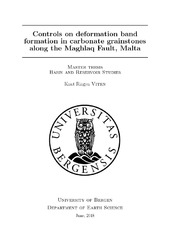Controls on deformation band formation in carbonate grainstones along the Maghlaq Fault, Malta.
Master thesis

View/
Date
2018-06-20Metadata
Show full item recordCollections
- Department of Earth Science [1096]
Abstract
Deformation bands are common structures in deformed porous rocks and sediments, that localise strain in millimetre to centimetre thick tabular zones. Deformation bands occurring in siliciclastic rocks have been described and studied in great detail over the last four decades, but only recently have the equivalent structures in carbonate rocks been allocated significant academic attention. The knowledge about how deformation bands evolve and affect petrophysical properties of the host rock is thus less established in carbonate rocks, prompting this study. Here, results of outcrop mapping and extensive analysis of microscopic observations are combined to determine the controlling factors on deformation band formation in the hangingwall of the extensional Maghlaq Fault on the southwestern coast of Malta. The studied deformation bands are outcropping in the carbonate grainstones of the Miocene Globigerina Limestone Formation (GLF), more specifically in the Lower Globigerina Member (LGLM) and the Middle Globigerina Member (MGLM). By means of micro-structural observations, the studied deformation bands were in terms of kinematics classified as compactional shear bands (CSB). Porosity reductions of up to one order of magnitude were measured inside CSBs, relative to the host rock. At the outcrop, CSBs with similar orientations are recorded in both LGLM and MGLM, but the frequency of bands in LGLM is significantly higher than in MGLM. Microanalysis determined that different deformation mechanisms have dominated the strain localisation in the two stratigraphic members, with pressure solution dominating in LGLM compated to cataclasis combined with granular flow in MGLM. The preferential nucleation of CSBs in one unit over the other can, on the basis observations in the study, be attributed to the following controlling factors: (i) larger echinoderm grain size, leading to fewer grain contact points which enhances pressure solution, (ii) higher proportion of intergranular porosity which enables more deformation by granular flow and (iii) lesser proportion of foraminifera bioclasts, who resist deformation by cataclasis and pressure solution more than other bioclasts in the grain assemblage. Deformation bands are known to affect fluid flow patterns in permeable, potential reservoir rocks. Further knowledge on how they form in porous carbonate rocks and which host rock properties promote their formation can help to predict the location and effect of subseismic deformation bands. The findings of this study can thus be of importance to projects related to geothermal reservoirs, groundwater aquifers, CO2 storage and production of hydrocarbons from carbonate reservoirs.